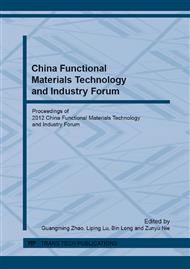p.3
p.7
p.11
p.15
p.19
p.25
p.30
p.35
The Influence of the Hydrothermal Temperature on the Morphologies and the Optical Absorption Properties of CuO Microrods
Abstract:
CuO microrods with a diameter range of 1-2 μm are successfully synthesized with 1 m mol CuCl2 as copper source and 1 m mol Na2CO3 as auxiliary salt at 240 °C for 24 h via the simple hydrothermal method. The phase, the morphologies and optical absorption properties of the samples have been characterized and analyzed by XRD (X-ray diffraction), SEM (Scanning electron microscope) and ultraviolet-visible absorption spectroscopy (UV-VIS), respectively. XRD analysis shows that the phase of as obtained samples is CuO. SEM analysis confirms that the increase of the reaction temperature is propitious to synthesize CuO microrods. And UV-VIS measurements show that CuO microrods have a good optical absorption property.
Info:
Periodical:
Pages:
15-18
Citation:
Online since:
May 2013
Authors:
Price:
Сopyright:
© 2013 Trans Tech Publications Ltd. All Rights Reserved
Share:
Citation:


